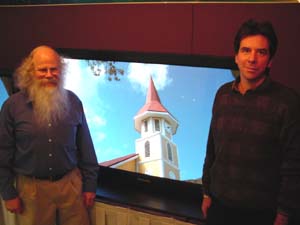The History of Plasma Displays
By Jamie Hutchinson
Owens-Illinois had sunk millions into manufacturing
plasma displays when it gave up on the business and
sold its plasma division in the 1970s. U.S. TV companies
didn't last long after they came to understand the investment
it would take to make plasma competitive with cathode
ray tubes. Computer companies stuck it out until 1987,
when IBM became the last major U.S. company to dump
its commercial plasma display business. That left only
the Pentagon to sustain a small but very lucrative plasma
display industry in the U.S.
Weber had derived most of his income from consulting
on the commercial side, so there wasn't a lot left to
do when IBM closed its plasma manufacturing plant in
Kingston, NY. Except perhaps to join forces with three
former IBM executives, buy the used equipment from the
plant (88 trailer truckloads of it), haul it to an old
apple juice factory in nearby Highland, and hang up
a shingle. Which is exactly what he did.
Plasmaco was also a U of I project in technology commercialization.
Weber remained on the CERL staff while serving as chief
technical officer of the company, and many Plasmaco
staff visited CERL for training. The university licensed
Plasmaco to use its plasma technology, which now included
energy-efficient driving circuitry developed by Weber
himself. (Every plasma TV on the market now incorporates
Weber's contributions, which are the subject of an ongoing
legal dispute between U of I and Fujitsu.)

Weber (left) took the Illinois technology to
Plasmaco and used it to bring in business. Here he
shows off a transparent screen with moving graphics
at a 1988 convention. (L. Weber)
In 1990, Weber moved to New York and assumed full-time
duties at the new company, which scraped by producing
monochrome plasma computer displays until 1993. But
by that time, liquid crystal displays had achieved color
and conquered the market. Plasmaco now faced foreclosure,
and the company's investors shook up the top management,
making Weber president and CEO and forcing him to fire
half his staff. "Things got very ugly with all
the creditors that were after us," recalled Weber.
"The sheriff was knocking at my door because we
couldn't even show up for court. The lawyers wouldn't
represent us because we hadn't paid them."
Weber convinced a banker to lend him $80,000 for components
to begin developing a color display. By the last day
of a 1994 industry convention in San Jose, CA, he was
able to rig a static display of colored stripes that
impressed people with its brightness and contrast ratio.
Weber then began a joint development program with Matsushita,
which bought Plasmaco in 1996 for $26 million, leaving
Weber in his position as president. Weber hired his
old student Bill Schindler (MSEE '82) to manage Plasmaco's
60-inch prototype project, unveiled in 1999 and widely
agreed to have the best contrast ratio in the industry.

Weber hired his old student Bill Schindler (right)
to head up Plasmaco's 60-inch prototype project. Weber
and Schindler are pictured here at Plasmaco headquarters
in Highland, NY, along with one of their 60-inch prototype
displays. (J. Hutchinson)
|